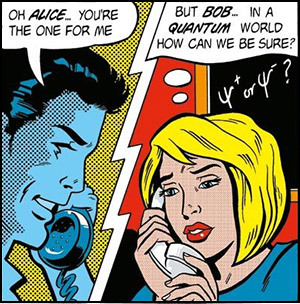Creating a Repository
Questions
- Where does Git store information?
Objectives
- Create a local Git repository.
- Describe the purpose of the
.gitdirectory.
Once Git is configured, we can start using it. For our examples, we’re using two characters with a long history in computer science and cryptography, Alice and Bob.

First, let’s create a new directory in the Desktop folder for our work and then change the current working directory to the newly created one:
cd ~/Desktop
mkdir mean
cd meanThen we tell Git to make mean a repository - a place where Git can store versions of our files:
git initInitialized empty Git repository in /Users/alice/Desktop/mean/.git/It is important to note that git init will create a repository that can include subdirectories and their files—there is no need to create separate repositories nested within the mean repository, whether subdirectories are present from the beginning or added later. Also, note that the creation of the mean directory and its initialization as a repository are completely separate processes.
If we use ls to show the directory’s contents, it appears that nothing has changed:
lsBut if we add the -a flag to show everything, we can see that Git has created a hidden directory within mean called .git:
# also use `-1` flag to get the output as a column
ls -a1.
..
.gitGit uses this special subdirectory to store all the information about the project, including the tracked files and sub-directories located within the project’s directory. If we ever delete the .git subdirectory, we will lose the project’s history.
Next, we will change the default branch to be called main. This might be the default branch depending on your settings and version of git. See the setup episode for more information on this change.
git checkout -b mainSwitched to a new branch 'main'We can check that everything is set up correctly by asking Git to tell us the status of our project:
git statusOn branch main
No commits yet
nothing to commit (create/copy files and use "git add" to track)If you are using a different version of git, the exact wording of the output might be slightly different.
Challenge: Places to Create Git Repositories
Along with tracking information about our base project (the project we have already created), Alice would also like to track information about her data collection. Despite Bob’s concerns, Alice creates a data project inside her mean project with the following sequence of commands:
cd ~/Desktop # return to Desktop directory
cd mean # go into mean directory, which is already a Git repository
ls -a # ensure the .git subdirectory is still present in the mean directory
mkdir data # make a subdirectory mean/data
cd data # go into data subdirectory
git init # make the data subdirectory a Git repository
ls -a # ensure the .git subdirectory is present indicating we have created a new Git repositoryIs the git init command, run inside the data subdirectory, required for tracking files stored in the data subdirectory?
Solution
No. Alice does not need to make the data subdirectory a Git repository because the mean repository can track any files, sub-directories, and subdirectory files under the mean directory. Thus, in order to track all information about her data, Alice only needed to add the data subdirectory to the mean directory.
Additionally, Git repositories can interfere with each other if they are “nested”: the outer repository will try to version-control the inner repository. Therefore, it’s best to create each new Git repository in a separate directory. To be sure that there is no conflicting repository in the directory, check the output of git status. If it looks like the following, you are good to go to create a new repository as shown above:
git statusfatal: Not a git repository (or any of the parent directories): .gitChallenge: Correcting git init Mistakes
Bob explains to Alice that a nested repository is redundant and may cause confusion down the road. Alice would like to remove the nested repository. How can Alice undo her last git init in the data subdirectory?
Solution
** USE WITH CAUTION! **
Background
Removing files from a Git repository needs to be done with caution. But we have not learned yet how to tell Git to track a particular file; we will learn this in the next episode. Files that are not tracked by Git can easily be removed like any other “ordinary” files with
rm filenameSimilarly a directory can be removed using rm -r dirname or rm -rf dirname. If the files or folder being removed in this fashion are tracked by Git, then their removal becomes another change that we will need to track, as we will see in the next episode.
Solution
Git keeps all of its files in the .git directory. To recover from this little mistake, Alice can just remove the .git folder in the data subdirectory by running the following command from inside the mean directory:
rm -rf data/.gitBut be careful! Running this command in the wrong directory will remove the entire Git history of a project you might want to keep. Therefore, always check your current directory using the command pwd.
But what happens if you WANT to have a nested repository, for example when you’re using a public project that you want to get updates for as part of your repository? Or a standard code library used across your entire lab/team that you all collectively maintain in another GitHub repo? This is the use case for something called submodules. Submodules are beyond the scope of this course, but we want to mention them here, in case you do need to do a version of the above, mixing open source software and your own tools in one repository.

Key Points
git initinitializes a repository.- Git stores all of its repository data in the
.gitdirectory.
All materials copyright Sydney Informatics Hub, University of Sydney